jazz的英文介绍
- 格式:doc
- 大小:29.50 KB
- 文档页数:3
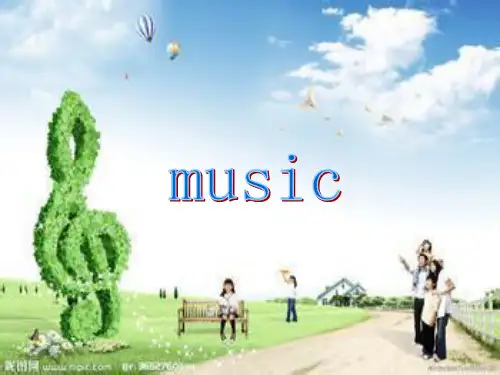

介绍音乐类型英语作文英文回答:Music is a form of art that expresses emotions and ideas through organized sound. It is a powerful form of communication that can transcend language and cultural barriers. There are countless genres of music, each with its own unique characteristics. Some of the most popular genres include:Classical music: This genre is characterized by its complex harmonies, melodies, and rhythms. It is typically performed by symphony orchestras or chamber ensembles.Pop music: This genre is characterized by its catchy melodies, simple harmonies, and danceable rhythms. It is typically performed by solo artists or bands.Rock music: This genre is characterized by its loud, distorted guitars, heavy drums, and aggressive vocals. Itis typically performed by bands.Jazz music: This genre is characterized by its improvisation, syncopated rhythms, and complex harmonies.It is typically performed by small ensembles.Hip-hop music: This genre is characterized by its rapping, DJing, and scratching. It is typically performedby DJs and rappers.Country music: This genre is characterized by its simple melodies, heartfelt lyrics, and twangy guitar playing. It is typically performed by solo artists or bands.Electronic music: This genre is characterized by its use of electronic instruments and sound effects. It is typically performed by DJs or producers.These are just a few of the many different genres of music that exist. Each genre has its own unique history, traditions, and audience. Music is a powerful art form that can touch our hearts, minds, and souls. It can make ushappy, sad, angry, or reflective. It can bring people together and create a sense of community.中文回答:音乐是一种艺术形式,通过有组织的声音表达情感和思想。
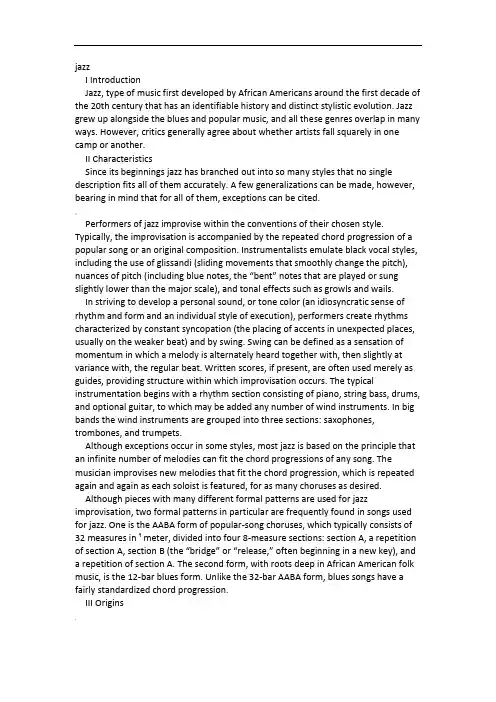
jazzI IntroductionJazz, type of music first developed by African Americans around the first decade of the 20th century that has an identifiable history and distinct stylistic evolution. Jazz grew up alongside the blues and popular music, and all these genres overlap in many ways. However, critics generally agree about whether artists fall squarely in one camp or another.II CharacteristicsSince its beginnings jazz has branched out into so many styles that no single description fits all of them accurately. A few generalizations can be made, however, bearing in mind that for all of them, exceptions can be cited.:Performers of jazz improvise within the conventions of their chosen style. Typically, the improvisation is accompanied by the repeated chord progression of a popular song or an original composition. Instrumentalists emulate black vocal styles, including the use of glissandi (sliding movements that smoothly change the pitch), nuances of pitch (including blue notes, the “bent” notes that are played or sung slightly lower than the major scale), and tonal effects such as growls and wails.In striving to develop a personal sound, or tone color (an idiosyncratic sense of rhythm and form and an individual style of execution), performers create rhythms characterized by constant syncopation (the placing of accents in unexpected places, usually on the weaker beat) and by swing. Swing can be defined as a sensation of momentum in which a melody is alternately heard together with, then slightly at variance with, the regular beat. Written scores, if present, are often used merely as guides, providing structure within which improvisation occurs. The typical instrumentation begins with a rhythm section consisting of piano, string bass, drums, and optional guitar, to which may be added any number of wind instruments. In big bands the wind instruments are grouped into three sections: saxophones, trombones, and trumpets.Although exceptions occur in some styles, most jazz is based on the principle that an infinite number of melodies can fit the chord progressions of any song. The musician improvises new melodies that fit the chord progression, which is repeated again and again as each soloist is featured, for as many choruses as desired. Although pieces with many different formal patterns are used for jazz improvisation, two formal patterns in particular are frequently found in songs used for jazz. One is the AABA form of popular-song choruses, which typically consists of 32 measures in ¹ meter, divided into four 8-measure sections: section A, a repetition of section A, section B (the “bridge” or “release,” often beginning in a new key), and a repetition of section A. The second form, with roots deep in African American folk music, is the 12-bar blues form. Unlike the 32-bar AABA form, blues songs have a fairly standardized chord progression.III Origins·Jazz is rooted in the mingled musical traditions of African Americans. These include traits surviving from West African music; black folk music forms developed in the Americas; European popular and light classical music of the 18th and 19th centuries; and later popular music forms influenced by black music or produced by black composers. Among the surviving African traits are vocal styles that include great freedom of vocal color; a tradition of improvisation; call-and-response patterns; and rhythmic complexity, both in the syncopation of individual melodic lines and in the conflicting rhythms played by different members of an ensemble. Black folk music forms include field hollers, rowing chants, lullabies, and later, spirituals and blues (see African American Music).European music contributed specific styles and forms: hymns, marches, waltzes, quadrilles, and other dance music, as well as light theatrical music and Italian operatic music. European music also introduced theoretical elements, in particular, harmony, both as a vocabulary of chords and as a concept related to musical form. (Much of the European influence was absorbed through private lessons in European music, even when the black musicians so trained could only find work in seedy entertainment districts and on Mississippi riverboats.)Black-influenced elements of popular music that contributed to jazz include the banjo music of the minstrel shows (derived from the banjo music of slaves), the syncopated rhythmic patterns of African-influenced Latin American music (heard in southern . cities), the barrelhouse piano styles of tavern musicians in the Midwest, and the marches played by black brass bands in the late 19th century. Near the end of the 19th century, another influential genre emerged. This was ragtime, a composed music that combined many elements, including syncopated rhythms (from banjo music and other black sources) and the harmonic contrasts and formal patterns of European marches. After 1910 bandleader W. C. Handy took another influential form, the blues, and broke its strict oral tradition by publishing his original blues songs. (Favored by jazz musicians, Handy’s songs found on e of their greatest interpreters in the 1920s in blues singer Bessie Smith, who recorded many of them.) The merging of these multiple influences into jazz is difficult to reconstruct because it occurred before the existence of recording, which has provided valuable documentation. Of course, individual musicians had varying backgrounds and few people were directly exposed to all of these influences. For example, most jazz artists were and are city dwellers and might have only known rural black forms indirectly.IV History*Most early jazz was played in small dance bands or by solo pianists. Besides ragtime and marches, the repertoire included all kinds of popular dance music and blues. The bands typically played at picnics, weddings, parades, and funerals. Characteristically, the bands played dirges on the way to funerals and lively marches on the way back. Blues and ragtime had arisen independently just a few years before jazz and continued to exist alongside it, influencing the style and forms of jazz and providing important vehicles for jazz improvisation.RAPThe traditional entertainment involving talking and singing (Rap) is in black slang words and expressions, is equal in “the conversation” (talking), is from New York impoverished black community. It by under machinery's rhythm sound's background, related fast a succession of ryhme the verse is a characteristic. One of this form origins was the past broadcasting station master of ceremonies in introduced when phonograph record used one kind fast, ryhme shoptalk language. Lapp's lyrics are humorous, are charming, often has sarcastic, in the 80s receives the black to welcome especially. The most representative orchestra is “the overt enemy” (Public Enemy). Sometimes Lapp also calls “the Shipp - ho pp” (hip-hop). In fact, the Shipp - hopp's meaning was wider, makes a general reference at that time New York street corner culture each ingredient, besides Lapp, but also had: (Lapp uses frequently) places with the hand on the record player turntable's phonograph record shuttle, sends out has the rhythm to blow the fricative; Phonograph record broadcast (DJ) when transformation phonograph record splicing canned music piece, cannot listen to the interrupt trace technique; Break dancing and so on.Reprimanding or traditional entertainment involving talking and singing music, rhythm and blue color music (R&B) style including the rhythmic vocals sophistry in music accompaniment. The accompaniment includes the electronic drum to strike generally with the sample (digital sound bite which isolates) is unified from other music sound recording. in 1979 the first reprimanding record has been created, and the style rose to has broken out in the US in。
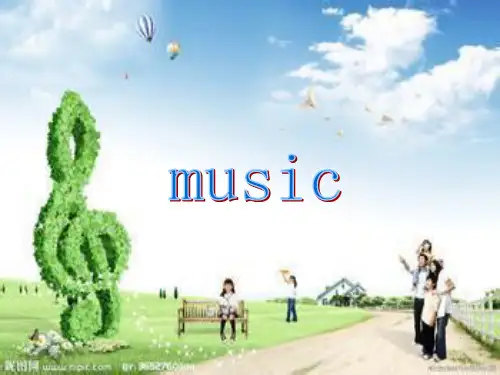
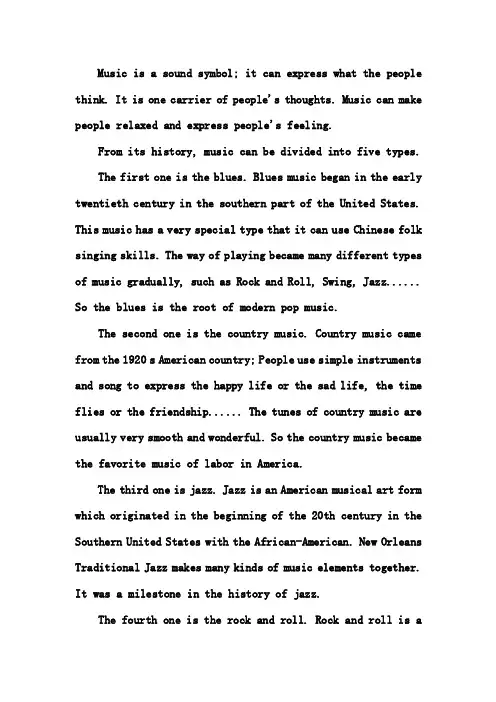
Music is a sound symbol; it can express what the people think. It is one carrier of people's thoughts. Music can make people relaxed and express people's feeling.From its history, music can be divided into five types.The first one is the blues. Blues music began in the early twentieth century in the southern part of the United States. This music has a very special type that it can use Chinese folk singing skills. The way of playing became many different types of music gradually, such as Rock and Roll, Swing, Jazz...... So the blues is the root of modern pop music.The second one is the country music. Country music came from the 1920 s American country; People use simple instruments and song to express the happy life or the sad life, the time flies or the friendship...... The tunes of country music are usually very smooth and wonderful. So the country music became the favorite music of labor in America.The third one is jazz. Jazz is an American musical art form which originated in the beginning of the 20th century in the Southern United States with the African-American. New Orleans Traditional Jazz makes many kinds of music elements together. It was a milestone in the history of jazz.The fourth one is the rock and roll. Rock and roll is akind of music type which created in 1940 s of the United States. Well, in 1950 s rock and roll quickly became popular in the world. Rock music with its flexible and bold to express people's feelings and young people all over the world love it very much.The last one is hip-hop music.Hip-hop music, also call it rap music and now rap music development up to now is not only a black music, it quickly throughout the world, and become a kind of unique pop music symbol. Hip-Hop is street culture, the manner of a kind of life.Well, today, I want to talk about the modern pop music.Pop music is a part of popular music in music genres. Compared with rock, hip-hop music, country music and jazz, it has no regular music style. For example: a singer who have many kinds of music style, such as rock, hip-hop, jazz and so on, we can call it a pop music singer.In the late 1950 s, a young people who called Elvis Presley created the pop music with many kinds of music. Since then, pop music just like a whirlwind swept the world music. His songs had been popular and continued for a long time.The Beatles were the most influential band of the pop music; it affects the rock band's music and development after 1960s era. The Beatles were as "the invasion" music culture in United States and influenced the Native American pop music development road more and more.Michael Jackson is the representative of the world popular culture. He had high fame and great influence in the world, and he known as “the king of pop”. He is a music all-rounder, in the lyricist, composer, scene production, singing, dancing and playing musical instruments are all had outstanding achievements. Michael Jackson had made his own kingdom in the modern pop music history.These are the history of the pop music in the world. However the traditional Chinese wind brings out the antique Chinese flavor.Jay Chou as "the king of pop in Asian" started "Chinese wind" first. He is especially good at R&B and Rap, also with the unique music material, singing skills and Fang Wensan’s lyrics, and his music breakthrough for Asian pop music turns over a new pageLeehom Wang makes the Chinese drama and hip-hop music combined, started the style of “chinked-out” and makes the Chinese wind to the world.。
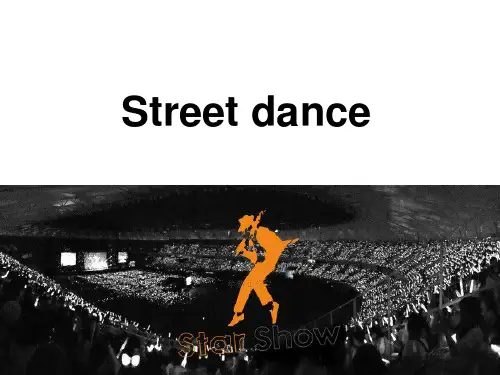
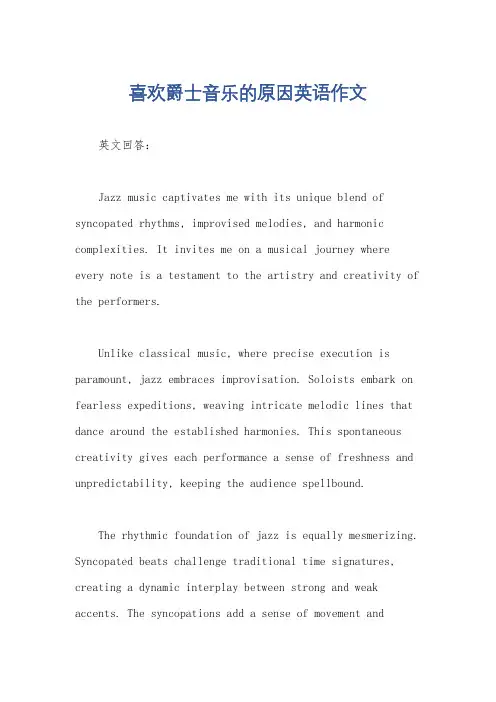
喜欢爵士音乐的原因英语作文英文回答:Jazz music captivates me with its unique blend of syncopated rhythms, improvised melodies, and harmonic complexities. It invites me on a musical journey where every note is a testament to the artistry and creativity of the performers.Unlike classical music, where precise execution is paramount, jazz embraces improvisation. Soloists embark on fearless expeditions, weaving intricate melodic lines that dance around the established harmonies. This spontaneous creativity gives each performance a sense of freshness and unpredictability, keeping the audience spellbound.The rhythmic foundation of jazz is equally mesmerizing. Syncopated beats challenge traditional time signatures, creating a dynamic interplay between strong and weak accents. The syncopations add a sense of movement andenergy to the music, propelling listeners forward.Harmonically, jazz ventures beyond the familiar chords of Western music. Extended chords, altered scales, and chromatic modulations create a rich and complex tapestry of sound. Jazz musicians have expanded the harmonic language, pushing the boundaries of musical expression.Beyond its technical intricacies, jazz embodies aspirit of freedom and experimentation. It encourages musicians to break away from conventions and explore uncharted territories. The genre has a rich history of innovators who have pushed the boundaries of jazz, creating new subgenres and influencing countless other musicians.The emotional range of jazz is vast and varied. It can evoke joy, sadness, melancholy, and excitement. Through its expressive melodies and harmonies, jazz music has the power to touch the depths of human emotion, resonating with listeners on a deeply personal level.In short, my love for jazz stems from its unparalleledcreativity, rhythmic complexity, harmonic sophistication, spirit of freedom, and emotional resonance. It is a genre that constantly surprises, delights, and inspires me.中文回答:爵士音乐以其独特的切分节奏、即兴旋律和和声复杂性吸引着我。
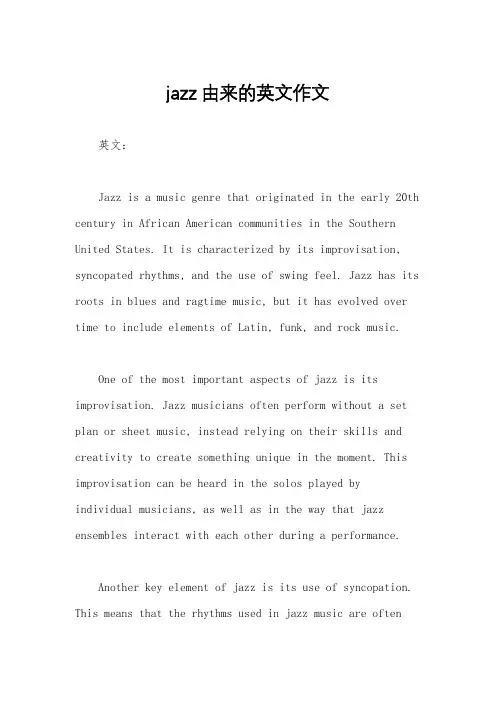
jazz由来的英文作文英文:Jazz is a music genre that originated in the early 20th century in African American communities in the Southern United States. It is characterized by its improvisation, syncopated rhythms, and the use of swing feel. Jazz has its roots in blues and ragtime music, but it has evolved over time to include elements of Latin, funk, and rock music.One of the most important aspects of jazz is its improvisation. Jazz musicians often perform without a set plan or sheet music, instead relying on their skills and creativity to create something unique in the moment. This improvisation can be heard in the solos played byindividual musicians, as well as in the way that jazz ensembles interact with each other during a performance.Another key element of jazz is its use of syncopation. This means that the rhythms used in jazz music are oftenoffbeat or unexpected, creating a sense of tension and release that is characteristic of the genre. Jazz musicians also use a swing feel, which involves playing with a rhythmic bounce that gives the music a lively, upbeat feel.Over the years, jazz has had a significant impact on popular music and culture. Many famous musicians, such as Louis Armstrong, Duke Ellington, and Miles Davis, have been associated with jazz. Jazz has also influenced other genres of music, such as rock, hip hop, and electronic music.In my opinion, jazz is a unique and fascinating genre of music. Its emphasis on improvisation and syncopation creates a sense of excitement and energy that is hard to find in other types of music. I also appreciate the waythat jazz musicians are able to interact with each other during a performance, creating something that is truly one-of-a-kind.中文:爵士乐是一种起源于20世纪初美国南部非裔社区的音乐流派。
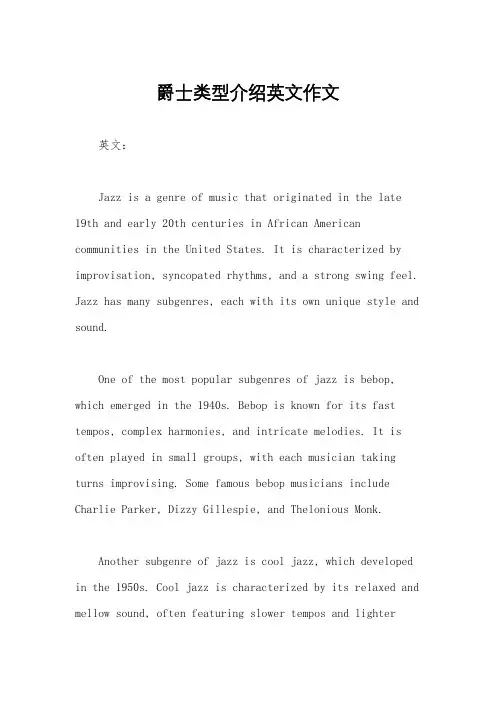
爵士类型介绍英文作文英文:Jazz is a genre of music that originated in the late19th and early 20th centuries in African American communities in the United States. It is characterized by improvisation, syncopated rhythms, and a strong swing feel. Jazz has many subgenres, each with its own unique style and sound.One of the most popular subgenres of jazz is bebop, which emerged in the 1940s. Bebop is known for its fast tempos, complex harmonies, and intricate melodies. It is often played in small groups, with each musician taking turns improvising. Some famous bebop musicians include Charlie Parker, Dizzy Gillespie, and Thelonious Monk.Another subgenre of jazz is cool jazz, which developed in the 1950s. Cool jazz is characterized by its relaxed and mellow sound, often featuring slower tempos and lighterinstrumentation. It is also known for its use of modal harmonies and innovative arrangements. Some famous cool jazz musicians include Miles Davis, Chet Baker, and Dave Brubeck.Latin jazz is another popular subgenre of jazz, which combines elements of jazz with Latin American rhythms and instrumentation. It emerged in the 1940s and 1950s, and has since become a staple of jazz music. Some famous Latin jazz musicians include Tito Puente, Mongo Santamaria, and Eddie Palmieri.中文:爵士音乐是起源于19世纪末和20世纪初的美国非裔社区的一种音乐流派。
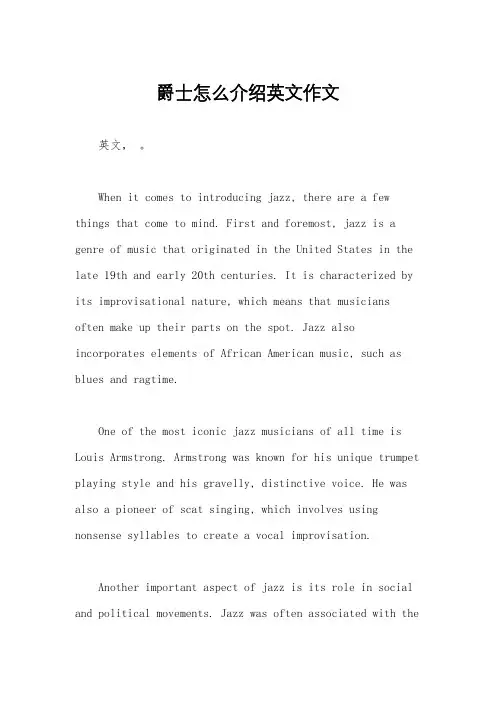
爵士怎么介绍英文作文英文,。
When it comes to introducing jazz, there are a few things that come to mind. First and foremost, jazz is a genre of music that originated in the United States in the late 19th and early 20th centuries. It is characterized by its improvisational nature, which means that musicians often make up their parts on the spot. Jazz also incorporates elements of African American music, such as blues and ragtime.One of the most iconic jazz musicians of all time is Louis Armstrong. Armstrong was known for his unique trumpet playing style and his gravelly, distinctive voice. He was also a pioneer of scat singing, which involves using nonsense syllables to create a vocal improvisation.Another important aspect of jazz is its role in social and political movements. Jazz was often associated with theCivil Rights movement in the 1960s, as many African American musicians used their music to express their struggles and advocate for change.Overall, jazz is a rich and complex genre of music that has played an important role in American history and culture.中文:介绍爵士乐时,我想到了几个关键点。
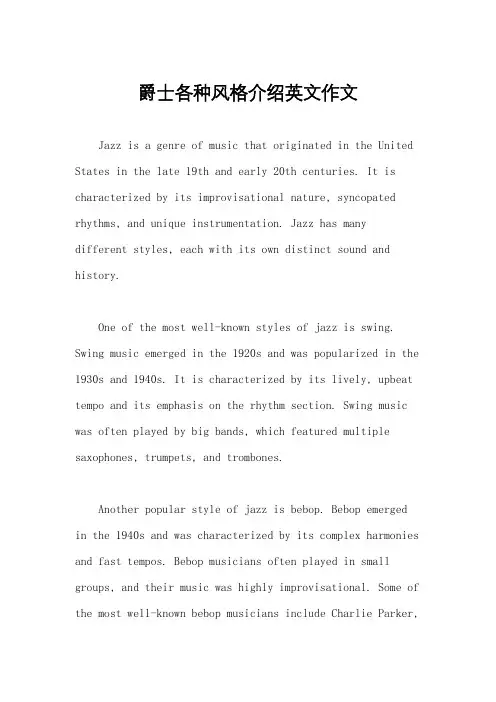
爵士各种风格介绍英文作文Jazz is a genre of music that originated in the United States in the late 19th and early 20th centuries. It is characterized by its improvisational nature, syncopated rhythms, and unique instrumentation. Jazz has manydifferent styles, each with its own distinct sound and history.One of the most well-known styles of jazz is swing. Swing music emerged in the 1920s and was popularized in the 1930s and 1940s. It is characterized by its lively, upbeat tempo and its emphasis on the rhythm section. Swing music was often played by big bands, which featured multiple saxophones, trumpets, and trombones.Another popular style of jazz is bebop. Bebop emergedin the 1940s and was characterized by its complex harmonies and fast tempos. Bebop musicians often played in small groups, and their music was highly improvisational. Some of the most well-known bebop musicians include Charlie Parker,Dizzy Gillespie, and Thelonious Monk.Cool jazz is another style of jazz that emerged in the 1950s. Cool jazz is characterized by its relaxed, mellow sound and its use of unconventional instrumentation. Cool jazz musicians often used instruments like the French horn and the cello, which were not typically used in jazz music. Some of the most well-known cool jazz musicians include Miles Davis and Dave Brubeck.Latin jazz is a fusion of jazz and Latin American music. It emerged in the 1940s and 1950s and is characterized byits use of Latin American rhythms and instruments. Latinjazz musicians often use instruments like the conga, bongo, and timbales. Some of the most well-known Latin jazz musicians include Tito Puente and Mongo Santamaria.Finally, fusion jazz is a style of jazz that emerged in the 1960s and 1970s. Fusion jazz is characterized by itsuse of electronic instruments and its incorporation of elements from other genres, such as rock and funk. Some of the most well-known fusion jazz musicians include MilesDavis and Herbie Hancock.In conclusion, jazz is a genre of music with many different styles, each with its own distinct sound and history. From swing to bebop to cool jazz to Latin jazz to fusion jazz, there is a style of jazz for everyone to enjoy. Jazz continues to be an important part of American culture and a beloved genre of music around the world.。
jazz由来的英文作文Jazz is a genre of music that originated in theAfrican-American communities of New Orleans in the late19th and early 20th centuries. It is characterized by swing and blue notes, call and response vocals, and improvisation. Jazz has its roots in blues and ragtime, and has evolved over time to incorporate elements of other musical genres such as rock, pop, and classical music.The term "jazz" is believed to have originated as a slang term in the early 20th century, possibly derived from the slang term "jasm," which meant energy, spirit, or vigor. Jazz music is known for its lively and energetic rhythms, and its ability to evoke a wide range of emotions in listeners.Jazz has been a major influence on popular music and culture, and has produced numerous subgenres such as swing, bebop, cool jazz, and fusion. It has also had a significant impact on dance, fashion, and social movements, and hasbeen associated with the liberation and empowerment of marginalized communities.Jazz musicians are known for their technical proficiency, creativity, and ability to communicate through their instruments. Improvisation is a key element of jazz music, and allows musicians to express themselves in a spontaneous and individualistic manner.Jazz has a rich history and has been performed and enjoyed by people all over the world. It continues to evolve and adapt to contemporary tastes and trends, while maintaining its core principles of innovation, expression, and freedom.。
喜欢跳爵士的英语作文英文回答:Jazz dance is a captivating art form that combines athleticism, musicality, and freedom of expression. Its origins can be traced back to the African diaspora in the United States, and it has since evolved into a diverserange of styles, each with its own unique characteristics.One of the most alluring aspects of jazz dance is its improvisational nature. Dancers are encouraged to interpret the music in their own way, creating spontaneous and unrepeatable performances. This freedom allows for a deep connection between the dancer and the music, resulting in a raw and emotive experience.Furthermore, jazz dance is highly technical, requiring dancers to possess exceptional coordination, flexibility, and strength. The movements are often complex and intricate, incorporating jumps, turns, and isolations. Dancers mustalso have a strong sense of rhythm and the ability to interpret the nuances of the music.While there are many different styles of jazz dance, some of the most popular include:Broadway jazz: Characterized by energetic and theatrical movements, often used in musicals and stage productions.Modern jazz: A more contemporary style that incorporates elements of modern dance and ballet, emphasizing flow and improvisation.Funk jazz: A funky and rhythmic style that often incorporates elements of hip-hop and street dance.Latin jazz: A fusion of jazz and Latin dance styles, featuring vibrant and syncopated rhythms.Jazz dance is a challenging but rewarding art form that offers endless opportunities for self-expression. Whetheryou are a seasoned professional or a complete beginner, there is a style of jazz dance that will suit you. If you are looking for a way to embrace your creativity, connect with your body, and experience the joy of dance, then jazz may be the perfect choice for you.中文回答:爵士舞是一种迷人的艺术形式,它融合了运动能力、音乐性和自由表达。
爵士音乐的英文作文英文:Jazz music is one of my favorite genres of music. It originated in the United States in the late 19th and early 20th centuries and has since spread throughout the world. Jazz music is characterized by its improvisation, swing rhythm, and use of syncopation.One of the things I love about jazz music is the freedom it allows for musicians to express themselves. Unlike other genres of music, jazz musicians are encouraged to improvise and create their own unique sound. This means that no two performances of a jazz song are ever the same.It's amazing to see how a group of musicians can come together and create something beautiful on the spot.Another aspect of jazz music that I appreciate is its ability to evoke emotions. Jazz music can be both upbeatand lively, or slow and melancholic. When I'm feeling happy,I love listening to jazz music that makes me want to dance. On the other hand, when I'm feeling down, I find solace in listening to slower, more emotional jazz songs.There are so many great jazz musicians out there, but some of my favorites include Louis Armstrong, Duke Ellington, and Miles Davis. These musicians were pioneersin the jazz world and helped to shape the genre into whatit is today.Overall, jazz music is a unique and beautiful genrethat I will always love.中文:爵士音乐是我最喜欢的音乐流派之一。
爵士音乐英文作文Jazz music is like a breath of fresh air, it's allabout improvisation and freedom. When you listen to jazz, you can feel the emotions and passion of the musicians pouring out through their instruments. It's raw, it's real, and it's always a unique experience.The beauty of jazz lies in its ability to bring people together. Whether you're at a jazz club or a music festival, the energy in the air is contagious. It doesn't matter if you're a jazz aficionado or a first-time listener, themusic has a way of captivating everyone in the room.One of the most fascinating aspects of jazz is its rich history. From its roots in African American culture to its influence on modern music, jazz has a story to tell. It's a genre that has evolved over time, blending different styles and influences to create something truly special.The musicians who play jazz are like storytellers,using their instruments to convey a message. They have a deep connection to the music, and it's evident in every note they play. Whether it's a smooth saxophone solo or a lively trumpet riff, you can't help but be moved by the talent and passion of these artists.Jazz is a genre that defies boundaries and rules. It's not afraid to push the envelope and experiment with new sounds. This sense of innovation is what keeps jazz fresh and exciting, even after all these years. It's a testament to the creativity and fearlessness of the musicians who continue to push the genre forward.In the end, jazz is more than just music – it's a way of life. It's about embracing the unknown, taking risks, and expressing yourself in a way that words cannot. So next time you have the chance, take a moment to listen to some jazz and let yourself be swept away by the magic of this incredible genre.。
爵士音乐介绍英文作文英文:Jazz music is a genre of music that originated in the late 19th and early 20th century in the African-American communities in the United States. It is characterized byits improvisation, swing feel, and use of blue notes, which are notes played at a slightly lower pitch than the major scale. Jazz music has a rich history and has influenced many other genres of music, including rock, pop, and hip hop.One of the defining features of jazz music is its improvisation. This means that musicians are free to create their own melodies and solos on the spot, without following a strict written score. This allows for a lot of creativity and spontaneity in jazz performances. For example, in a jazz band, a saxophonist might take a solo and create a completely new melody that has never been played before.Another important aspect of jazz music is its swing feel. This refers to the rhythmic pattern of the music, which is characterized by a strong emphasis on the off-beats. This gives jazz music a lively and energetic feel, and makes it great for dancing. For example, when listening to a jazz piece, you might find yourself tapping your footor nodding your head to the beat.Lastly, jazz music often uses blue notes, which are notes played at a slightly lower pitch than the major scale. This gives jazz music a unique sound that is different from other genres of music. For example, in a jazz piece, a pianist might play a bluesy riff that uses a lot of blue notes, giving the music a soulful and emotional quality.中文:爵士音乐是一种起源于19世纪末20世纪初的音乐流派,发源于美国非裔社区。
爵士舞蹈的英文作文英文回答:Jazz Dance。
Jazz dance is a dynamic and expressive dance form that originated in the African-American communities of the United States in the early 20th century. It is characterized by its strong rhythms, syncopated steps, and improvisational qualities.History of Jazz Dance。
The roots of jazz dance can be traced back to African dance traditions, which were brought to the Americas by enslaved Africans. These dances were often characterized by their rhythmic complexity and expressive movements. In the early 1900s, African-American dancers began to incorporate elements of other dance forms, such as ballet and tap, into their own dances. This fusion of styles gave birth to whatis now known as jazz dance.Elements of Jazz Dance。
Jazz dance is a versatile dance form that incorporates a wide range of movements and techniques. Some of the key elements of jazz dance include:Strong rhythms: Jazz dance is known for its strong and syncopated rhythms. Dancers often use their feet, hands, and bodies to create rhythmic patterns.Syncopated steps: Syncopation is a technique in which the dancer emphasizes off-beat rhythms. This creates a sense of tension and excitement.Improvisation: Jazz dance is often characterized byits improvisational qualities. Dancers may create their own steps and combinations on the spot.Isolation: Isolation is a technique in which the dancer moves one part of their body independently from therest. This creates a sense of fluidity and grace.Body awareness: Jazz dancers must have a strong sense of body awareness in order to execute the complex movements and rhythms of jazz dance.Styles of Jazz Dance。
jazzI IntroductionJazz, type of music first developed by African Americans around the first decade of the 20th century that has an identifiable history and distinct stylistic evolution. Jazz grew up alongside the blues and popular music, and all these genres overlap in many ways. However, critics generally agree about whether artists fall squarely in one camp or another.II CharacteristicsSince its beginnings jazz has branched out into so many styles that no single description fits all of them accurately. A few generalizations can be made, however, bearing in mind that for all of them, exceptions can be cited. Performers of jazz improvise within the conventions of their chosen style. Typically, the improvisation is accompanied by the repeated chord progression of a popular song or an original composition. Instrumentalists emulate black vocal styles, including the use of glissandi (sliding movements that smoothly change the pitch), nuances of pitch (including blue notes, the “bent” notes that are played or sung slightly lower than the major scale), and tonal effects such as growls and wails.In striving to develop a personal sound, or tone color (an idiosyncratic sense of rhythm and form and an individual style of execution), performers create rhythms characterized by constant syncopation (the placing of accents in unexpected places, usually on the weaker beat) and by swing. Swing can be defined as a sensation of momentum in which a melody is alternately heard together with, then slightly at variance with, the regular beat. Written scores, if present, are often used merely as guides, providing structure within which improvisation occurs. The typical instrumentation begins with a rhythm section consisting of piano, string bass, drums, and optional guitar, to which may be added any number of wind instruments. In big bands the wind instruments are grouped into three sections: saxophones, trombones, and trumpets. Although exceptions occur in some styles, most jazz is based on the principle that an infinite number of melodies can fit the chord progressions of any song. The musician improvises new melodies that fit the chord progression, which is repeated again and again as each soloist is featured, for as many choruses as desired.Although pieces with many different formal patterns are used for jazz improvisation, two formal patterns in particular are frequently found in songs used for jazz. One is the AABA form of popular-song choruses, which typically consists of 32 measures in ¹ meter, divided into four 8-measure sections: section A, a repetition of section A, section B (the “bridge” or “release,” often beginning in a new key), and a repetition of section A. The second form, with roots deep in African American folk music, is the 12-bar blues form. Unlike the 32-bar AABA form, blues songs have a fairly standardized chord progression. III OriginsJazz is rooted in the mingled musical traditions of African Americans. These include traits surviving from West African music; black folk music forms developed in the Americas; European popular and light classical music of the 18th and 19th centuries; and later popular music forms influenced by black music or produced by black composers. Among the surviving African traits are vocal styles that include great freedom of vocal color; a tradition of improvisation; call-and-response patterns; and rhythmic complexity, both in the syncopation of individual melodic lines and in the conflicting rhythms played by different members of an ensemble. Black folk music forms include field hollers, rowing chants, lullabies, and later, spirituals and blues (see African American Music).European music contributed specific styles and forms: hymns, marches, waltzes, quadrilles, and other dance music, as well as light theatrical music and Italian operatic music. European music also introduced theoretical elements, in particular, harmony, both as a vocabulary of chords and as a concept related to musical form. (Much of the European influence was absorbed through private lessons in European music, even when the black musicians so trained could only find work in seedy entertainment districts and on Mississippi riverboats.)Black-influenced elements of popular music that contributed to jazz include the banjo music of the minstrel shows (derived from the banjo music of slaves), the syncopated rhythmic patterns of African-influenced Latin American music (heard in southern U.S. cities), the barrelhouse piano styles of tavern musicians in the Midwest, and the marches played by black brass bands in the late 19th century. Near the end of the 19th century, another influential genre emerged. This was ragtime, a composed music that combined many elements, including syncopated rhythms (from banjo music and other black sources) and the harmonic contrasts and formal patterns of European marches. After 1910 bandleader W. C. Handy took another influential form, the blues, and broke its strict oral tradition by publishing his original blues songs. (Favored by jazz musicians, Handy’s songs found one of their greatest interpreters in the 1920s in blues singer Bessie Smith, who recorded many of them.)The merging of these multiple influences into jazz is difficult to reconstruct because it occurred before the existence of recording, which has provided valuable documentation. Of course, individual musicians had varying backgrounds and few people were directly exposed to all of these influences. For example, most jazz artists were and are city dwellers and might have only known rural black forms indirectly.IV HistoryMost early jazz was played in small dance bands or by solo pianists. Besides ragtime and marches, the repertoire included all kinds of popular dance music and blues. The bands typically played at picnics, weddings, parades, and funerals. Characteristically, the bands played dirges on the way to funerals and lively marches on the way back. Blues and ragtime had arisenindependently just a few years before jazz and continued to exist alongside it, influencing the style and forms of jazz and providing important vehicles for jazz improvisation.RAPThe traditional entertainment involving talking and singing (Rap) is in black slang words and expressions, is equal in “the conversation” (talking), is from New York impoverished black community. It by under machinery's rhythm sound's background, related fast a succession of ryhme the verse is a characteristic. One of this form origins was the past broadcasting station master of ceremonies in introduced when phonograph record used one kind fast, ryhme shoptalk language. Lapp's lyrics are humorous, are charming, often has sarcastic, in the 80s receives the black to welcome especially. The most representative orchestra is “the overt enemy” (Public Enemy). Sometimes Lapp also calls “the Shipp - hopp” (hip-hop). In fact, the Shipp - hopp's meaning was wider, makes a general reference at that time New York street corner culture each ingredient, besides Lapp, but also had: (Lapp uses frequently) places with the hand on the record player turntable's phonograph record shuttle, sends out has the rhythm to blow the fricative; Phonograph record broadcast (DJ) when transformation phonograph record splicing canned music piece, cannot listen to the interrupt trace technique; Break dancing and so on.Reprimanding or traditional entertainment involving talking and singing music, rhythm and blue color music (R&B) style including the rhythmic vocals sophistry in music accompaniment. The accompaniment includes the electronic drum to strike generally with the sample (digital sound bite which isolates) is unified from other music sound recording. in 1979 the first reprimanding record has been created, and the style rose to has broken out in the US in。